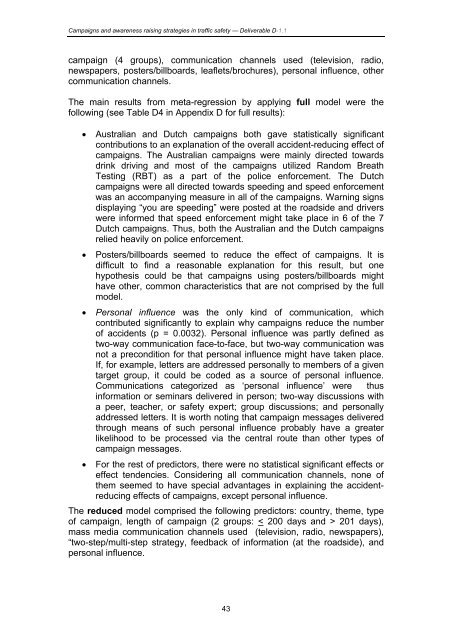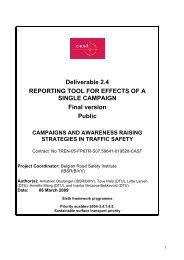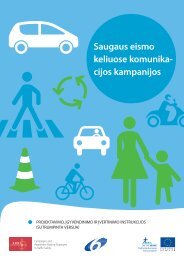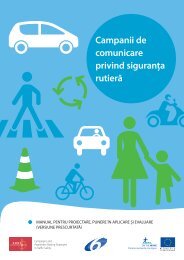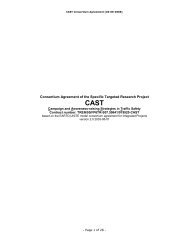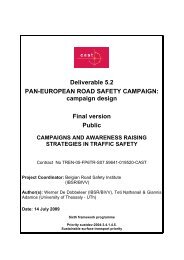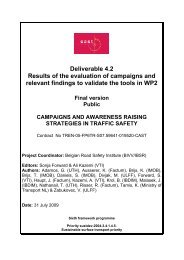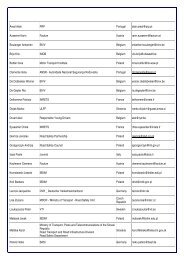Deliverable D 1.3 RESULTS OF META-ANALYSIS ... - cast-eu.org
Deliverable D 1.3 RESULTS OF META-ANALYSIS ... - cast-eu.org
Deliverable D 1.3 RESULTS OF META-ANALYSIS ... - cast-eu.org
You also want an ePaper? Increase the reach of your titles
YUMPU automatically turns print PDFs into web optimized ePapers that Google loves.
Campaigns and awareness raising strategies in traffic safety — <strong>Deliverable</strong> D-1.1campaign (4 groups), communication channels used (television, radio,newspapers, posters/billboards, leaflets/brochures), personal influence, othercommunication channels.The main results from meta-regression by applying full model were thefollowing (see Table D4 in Appendix D for full results):• Australian and Dutch campaigns both gave statistically significantcontributions to an explanation of the overall accident-reducing effect ofcampaigns. The Australian campaigns were mainly directed towardsdrink driving and most of the campaigns utilized Random BreathTesting (RBT) as a part of the police enforcement. The Dutchcampaigns were all directed towards speeding and speed enforcementwas an accompanying measure in all of the campaigns. Warning signsdisplaying “you are speeding” were posted at the roadside and driverswere informed that speed enforcement might take place in 6 of the 7Dutch campaigns. Thus, both the Australian and the Dutch campaignsrelied heavily on police enforcement.• Posters/billboards seemed to reduce the effect of campaigns. It isdifficult to find a reasonable explanation for this result, but onehypothesis could be that campaigns using posters/billboards mighthave other, common characteristics that are not comprised by the fullmodel.• Personal influence was the only kind of communication, whichcontributed significantly to explain why campaigns reduce the numberof accidents (p = 0.0032). Personal influence was partly defined astwo-way communication face-to-face, but two-way communication wasnot a precondition for that personal influence might have taken place.If, for example, letters are addressed personally to members of a giventarget group, it could be coded as a source of personal influence.Communications categorized as ‘personal influence’ were thusinformation or seminars delivered in person; two-way discussions witha peer, teacher, or safety expert; group discussions; and personallyaddressed letters. It is worth noting that campaign messages deliveredthrough means of such personal influence probably have a greaterlikelihood to be processed via the central route than other types ofcampaign messages.• For the rest of predictors, there were no statistical significant effects oreffect tendencies. Considering all communication channels, none ofthem seemed to have special advantages in explaining the accidentreducingeffects of campaigns, except personal influence.The reduced model comprised the following predictors: country, theme, typeof campaign, length of campaign (2 groups: < 200 days and > 201 days),mass media communication channels used (television, radio, newspapers),“two-step/multi-step strategy, feedback of information (at the roadside), andpersonal influence.43


